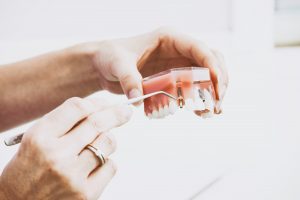
One way to fix the problem of missing teeth is with dental implants.1 With a dental implant, a screw-like device is implanted into a patient’s jawbone. This acts as an anchor for an artificial tooth, called a crown. A device called an abutment attaches to the anchor on one end and the crown on the other. The crown is custom made to fit the person’s mouth and to match the color of the existing teeth. Newer implants are made as one-piece systems. There are two types of dental implants: titanium and zirconia. The majority of dental implants are made of titanium due to their durability and cost-effectiveness. Titanium has been used in medical applications since the 1950s. Zirconia is nonmetallic but strong and durable. It’s also hypoallergenic. Zirconia is an option for people who are allergic to titanium. Patients may choose zirconia implants for several other reasons also. Zirconia implants are white. Those with receding gums may prefer an implant that offers a more natural look as opposed to titanium implants which can make the gums appear gray. Zirconia implants can be placed immediately following a tooth extraction, which results in shorter recovery time and less pain following the procedure. The one-piece design also eliminates the problem of bacteria possibly getting in between the anchor and abutment in two-piece titanium implants and zirconia is more resistant to corrosion than titanium. Zirconia implants are expected to be the fastest-growing segment through at least 2027.
Today’s market size shows global dental implant revenues for 2019 and 2027. Data for 2027 are projected. In 2019, Europe had the highest share of revenues, followed by North America and the Asia-Pacific region. In 2018, the European Union had 101.1 million people aged 65 and older. This number is projected to reach nearly 150 million by 2050, or 28.5% of the population. Older adults are more likely to experience tooth decay and tooth loss. As a result, the market for dental implants in Europe is expected to continue to grow over this time period. The Asia-Pacific region is expected to be the fastest-growing market through 2027 due to an aging population that is experiencing an increased incidence of osteoporosis and calcium deficiency leading to tooth loss. In addition, increasing economic stability and disposable income allowing people to afford the procedures will contribute to this growth. In the United States, nearly 5 million implants are placed yearly according to the American Dental Association. An estimated 69% of Americans between the ages of 35 and 44, the average age range when tooth loss begins, have at least one missing tooth. Twenty-four percent of those 74 years and older are completely edentulous. High demand coupled with a growing subset of the population able to afford dental implants will contribute to growth in the United States. Worldwide, an increasing number of dental injuries due to traffic accidents and sports injuries will also contribute to industry growth over this time period.
Leading dental implant manufacturers include BioHorizons IPH, Inc.; Nobel Biocare Services AG; Zimmer Biomet Holdings, Inc.; OSSTEM IMPLANT; Institut Straumann AG; Bicon, LLC; Leader Italy; Anthogyr SAS; DENTIS; DENTSPLY Sirona; DENTIUM Co., Ltd.; T-Plus Implant Tech. Co.; and KYOCERA Medical Corporation.
1 As with all surgical procedures, there are risks of complications. Also, not all people with missing teeth are candidates for dental implants. A person’s overall health and health of the bone and tissue at the implant site are factors dental surgeons take into consideration before performing dental implant surgery.
Geographic reference: World
Year: 2019 and 2027
Market size: $4.6 billion and $9.0 billion, respectively
Sources: “Dental Implants Market Size, Share & Trends Analysis Report by Type (Titanium, Zirconia), by Region (North America, Europe, Asia Pacific, Latin America, MEA), and Segment Forecasts, 2020 – 2027,” Grand View Research Report Summary, March 2020 available online here; “Dental Implants Market Size Worth $9.0 Billion by 2027 | CAGR: 9.0%: Grand View Research, Inc.,” CISION PR Newswire, March 18, 2020 available online here; “Can a New Smile Make You Appear More Successful and Intelligent?” Consumer Studies available online here; “What to Know About Dental Implants,” Medical News Today available online here; Bill Smye, “Everything About Titanium for Orthopedic Applications,” Matmatch, October 12, 2017 available online here; “7 Reasons You Might Choose Metal-Free Zirconia Dental Implants,” Friedman Dental Group, May 14, 2017 available online here; “Ageing Europe: Looking at the Lives of Older People in the EU 2019 Edition,” Eurostat, September 2019 available online here.
Image source: Peter Kasprzyk, “Dental Implants,” Unsplash, July 14, 2016 available online here.
